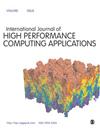High-throughput virtual laboratory for drug discovery using massive datasets
IF 2.5
3区 计算机科学
Q2 COMPUTER SCIENCE, HARDWARE & ARCHITECTURE
International Journal of High Performance Computing Applications
Pub Date : 2021-03-23
DOI:10.1177/10943420211001565
引用次数: 26
Abstract
Time-to-solution for structure-based screening of massive chemical databases for COVID-19 drug discovery has been decreased by an order of magnitude, and a virtual laboratory has been deployed at scale on up to 27,612 GPUs on the Summit supercomputer, allowing an average molecular docking of 19,028 compounds per second. Over one billion compounds were docked to two SARS-CoV-2 protein structures with full optimization of ligand position and 20 poses per docking, each in under 24 hours. GPU acceleration and high-throughput optimizations of the docking program produced 350× mean speedup over the CPU version (50× speedup per node). GPU acceleration of both feature calculation for machine-learning based scoring and distributed database queries reduced processing of the 2.4 TB output by orders of magnitude. The resulting 50× speedup for the full pipeline reduces an initial 43 day runtime to 21 hours per protein for providing high-scoring compounds to experimental collaborators for validation assays.使用海量数据集进行药物发现的高通量虚拟实验室
针对COVID-19药物发现的基于结构的大规模化学数据库筛选的解决时间缩短了一个数量级,并且在Summit超级计算机上的多达27,612个gpu上大规模部署了虚拟实验室,平均每秒可以对接19,028种化合物。超过10亿个化合物在24小时内与两个SARS-CoV-2蛋白结构对接,并对配体位置进行了充分优化,每次对接有20个姿势。对接程序的GPU加速和高吞吐量优化比CPU版本产生了350倍的平均加速(每个节点50倍的加速)。基于机器学习的评分和分布式数据库查询的特征计算的GPU加速减少了2.4 TB输出的处理数量级。由此产生的50倍加速将每个蛋白质的初始43天运行时间缩短到21小时,从而为实验合作者提供高评分化合物进行验证分析。
本文章由计算机程序翻译,如有差异,请以英文原文为准。
求助全文
约1分钟内获得全文
求助全文
来源期刊
CiteScore
6.10
自引率
6.50%
发文量
32
审稿时长
>12 weeks
期刊介绍:
With ever increasing pressure for health services in all countries to meet rising demands, improve their quality and efficiency, and to be more accountable; the need for rigorous research and policy analysis has never been greater. The Journal of Health Services Research & Policy presents the latest scientific research, insightful overviews and reflections on underlying issues, and innovative, thought provoking contributions from leading academics and policy-makers. It provides ideas and hope for solving dilemmas that confront all countries.

 求助内容:
求助内容: 应助结果提醒方式:
应助结果提醒方式:


